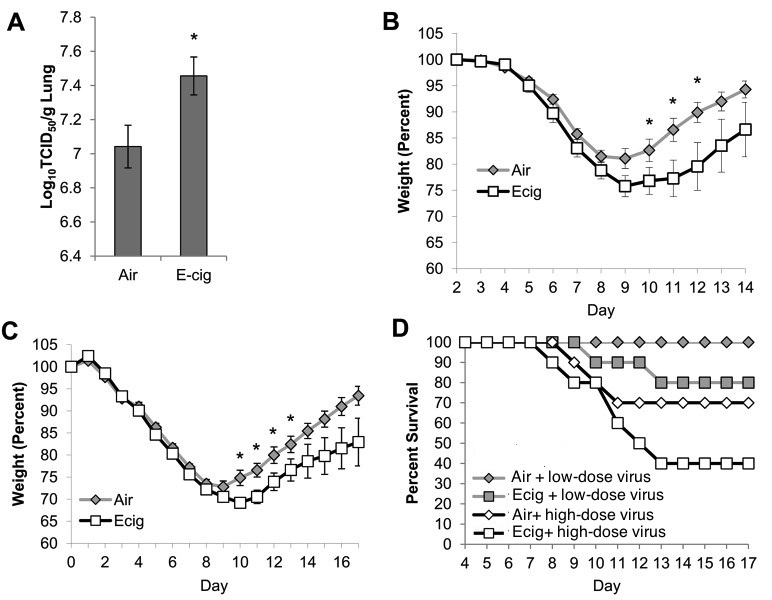ASHES, Vol. 11(2) – Is the safety of E-cigarettes about to go up in smoke?
Awareness and use of e-cigarettes is growing across the globe (ASHES, Vol. 9(6)). Some have suggested that e-cigarettes might be a healthy alternative to cigarettes (ASHES, Vol. 6(4)) or be used for nicotine replacement therapy to help people quit cigarettes (ASHES, Vol. 7(3); ASHES, Vol. 9(13). However, because e-cigarettes are not well regulated, their components and the effects of exposure to these components are not well understood. This week’s ASHES reviews a study that examined the effects of e-cigarettes on the lungs of mice, particularly in terms of susceptibility to infection (Sussan et al., 2015).
Methods
- Researchers randomly assigned 2 month old mice to either an e-cigarette treatment condition or filtered air control.
- For two weeks, mice in the treatment group were exposed to the vapor of a national available brand of e-cigarette (i.e., NJOY) twice daily for 1.5 hours.
- Mice in the control condition were exposed to filtered air.1 hour after completing the last exposure session, all mice were exposed to influenza (high or low concentration) via intranasal injections[1].
- A subset of mice were euthanized after 4 days and tests were done to determine levels of infection.
- The rest of the mice were observed for more than 2 weeks to see how they responded to the infection.
Results
- As Figure 1A shows, mice in the e-cigarettes condition were significantly more susceptible than control mice to the virus as measured by viral load in the lungs 4 days after infection.
- Figures 1B and 1C show that for a two week period after exposure to the virus, mice in both conditions experienced significant weight loss.
- Mice exposed to a lower concentration of the virus (Figure 1B) lost less weight than those exposed to a higher concentration (Figure 1C).
- Mice in the control condition began to recover and gain weight more quickly than the e-cigarette group starting at about day 10.
- Figure 1D shows the percent of mice still alive, cumulatively for 17 days after the last exposure session. This reveals that mice in the e-cigarette condition were more likely to die from the virus than mice in the control condition.
- Figure 1D also shows a dose response relationship between the concentration of the flu virus and survival—exposure to e-cigarettes was especially harmful to mice exposed to higher concentrations of the flu.
Figure 1. Comparison of Mice in the E-cigarette Condition to Control Mice on Viral Concentration (1A), Morbidity as Measured by Weight Loss (1B and 1C), and Mortality (1D). Click image to enlarge.
Notes. Figure 1A shows viral titer of mice infected with lower concentration of H1N1 virus 4 days after infection (N = 5 mice per group). Figure 1B shows daily weight of mice infected with lower dose of H1N1. Figure 1C is the same but for mice exposed to higher dose of H1N1. Values are presented as percent of starting weight (N = 10 mice per group). Figure 1D shows mortality curves in response to intranasal infection with lower concentration or higher concentration H1N1 (N = 10 mice per group). *p<0.05 by Student’s two-tailed t-test. © 2015 Sussan et al. (2015), with modifications to the legend in 1D.
Limitations
- It’s unclear whether the pathway and response in humans can be assumed to be similar to that in mice.
- This experiment relied on one brand of e-cigarette and liquid mixture. There are likely differences in the vaporizer or the mixture (e.g., additives, nicotine concentration) which might alter the outcomes seen in this study.
Conclusion
This study highlights the potential for e-cigarette vapor to lead to immune deficiency, morbidity, and possibly mortality in an animal model. The results bring into question the safety of e-cigarettes, and the ability to safely use them for nicotine replacement therapy and cessation. These findings suggest that e-cigarettes must be rigorously tested for safety, and their potential pathways to disease must be more fully understood, before they can be promoted as a safe alternative to smoking.
— John Kleschinsky @JHKleschinsky
What do you think? Please use the comment link below to provide feedback on this article.
Reference
Sussan TE, Gajghate S, Thimmulappa RK, Ma J, Kim J-H, et al. (2015) Exposure to Electronic Cigarettes Impairs Pulmonary Anti-Bacterial and Anti-Viral Defenses in a Mouse Model. PLoS ONE 10(2): e0116861. doi:10.1371/journal.pone.0116861
________________
[1] The full study examined both bacterial and viral infections. This review only looks at the viral infection because the results were similar and because only the viral infection includes test of morbidity and mortality.
